Kenny Dorham “Afro-Cuban” Blue Note/Classic Records
- Performance:

- Sound:

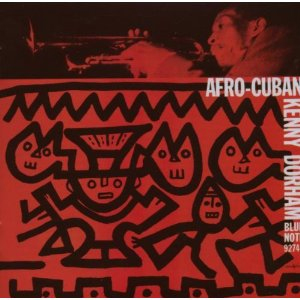
I’ve often lamented the lack of a real rock and roll scene in San Francisco. If it’s happening, I don’t know where. It seems like you could go out every night for three straight months and watch a different Afro-Cuban jam band though. Or Haitian-Funk this and that. Bands with twenty something members making a racket that three accomplished players could make by themselves. Or whatever. That’s my take on it, anyways. I got so burnt on the arrangement that I’d almost forgotten how fun and moving Cuban tunes could be until I was reminded by a local crime author that sets some of his stories in Havana. By moving, I mean irresistible. As Classic Records enters the twilight of its life, I’m left scouring the online retailers for their titles with prices that haven’t been jacked through the roof. Luckily, I found one by Kenny Dorham. At least, his is the name on the cover. He also employs people with names like Horace Silver, Hank Mobley, and Art Blakey on this release. Basically, it’s by the Jazz Messengers lineup that I know best with a little help from outside. It’s called, simply enough, “Afro-Cuban.” I’m surprised the live music venues in town aren’t wallpapered with its artwork. There’s still time, I guess, and actually you could do worse. It’s a very striking cover.
And the music hits hard too. The opener is called “Afrodisia,” and I swear I think that was the name of one of the hippy bands I saw when I moved here five years ago. They weren’t playing like this though. And this isn’t really Cuban music. This is Cuban flavored music and a lot of that comes from the percussionist, Carlos “Potato” Valdes. He sounds like he has about nine arms when the music calls for it. On slower numbers, like “Lotus Flower,” he serves more as the garnish than the main course. In fact, “Lotus Flower” doesn’t sound too Cuban to me, but I don’t know tons about Cuban music. “Minor’s Holiday” gets things swinging again, and gets Valdes’s arms flying again too. Again, this is Blue Note jazz with worldly accents as best I can tell. I’m not sure that I’d even make the connection without the added percussion, at least on “Minor’s Holiday.” The songs from the “Afro-Cuban” sessions comprise all of Side A and were originally released as a 10″ record while Side B is made up of straight jazz tunes from another session with a smaller lineup. The original “Afro-Cuban” tunes are outright infectious, especially “Afrodisia” and “Baheer’s Dream” which closes the side. The three Dorham originals on Side B swing like you’d expect from the Blue Note masters. There’s not a weak song amongst them and it’s hard to imagine that they’d been unreleased prior to the odd pairing with the other tunes. I’m glad they made it out, and you will be too if you like this style of jazz. This group smokes. No further questions, Your Honor.
Original copies of “Afro-Cuban” are pricey if they’re in decent condition. They’re exorbitant if they’re in really good condition so I felt fine about plunking down some cash for this one while I still can. I found a sealed copy for list price on Ebay, and Acoustic Sounds has purchased the Classic Records remaining catalogue so they should have it too. It’s well worth the money, I can assure you. If you’re familiar with Classic Records, you know what you can expect. If you’re not, you’re not completely out of luck because Analogue Productions is already releasing some of the same Blue Note titles on 45rpm double-disc sets. Both are sonically astonishing, but I can’t tell enough of a difference between the two formats to warrant the extra money on the AP releases. That’s not to say they’re over priced. They’re fine pressings of exquisite titles, there’s no arguing that. But a Classic Records reissue is going to list for about $32 on a single disc while the corresponding 45’s are around $50. If I were rich, I’d run out and by copies of each for comparison. If you have a highly developed ear, you will probably prefer the AP’s as everyone knows that you can’t beat a 45 (unless you can find a 78). This title is available in both formats so take your pick, whichever you’re drawn to. I’m happy to have mine on 200-gram mono virgin vinyl for now. Now, I’m going to quit typing and put on my guayabera shirt and smoke a smuggled cigar while I listen to “Afro-Cuban.” Again.
Bill Evans Trio “Waltz For Debby” Riverside/Analogue Productions
- Performance:

- Sound:

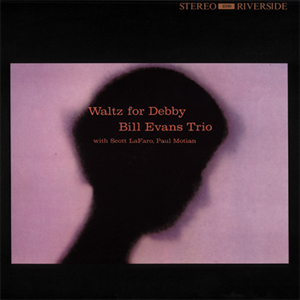
A friend of mine became aware of my recent jazz acquisitions a couple of months back and recommended “Sunday At The Village Vanguard” by Bill Evans. I did a little digging around, and the first thing I noticed was that this guy doesn’t look like much of a jazzer to me. At least, not the ones I’m most familiar with. For one thing, he’s white. For another, he looks decidedly unhip even by white folks’ standards. So, I dug a little deeper and found that he was the pianist on “Kind Of Blue” which I should have known already. I don’t care what look you’re sporting, being a featured player (or a player at all) on “Kind Of Blue” is a jazz resume´ in and of itself. I thought I’d better check this guy out so I began looking around online for an original copy of the “Vanguard” record. Right. A near mint copy consistently sells for around $600 and one of my trusted re-issue companies is perpetually backordered on the title. More research showed that the “Vanguard” recordings spilled over onto another release called “Waltz For Debby,” and I eventually came away with a copy from Analogue Productions. The tunes on both records were recorded on June 25, 1961, ten days before the trio’s bassist died in a car accident. It’s not what I’m used to, and that’s what I love about music. You can always dig a little deeper in the well and occasionally pull something out that’s going to open strange doors leading to exotic locales. This is one of those.
“My Foolish Heart” opens the album and it’s a quiet, moody piece that moves slowly, but is in no way plodding or sad. Contemplative, maybe. The entire collaboration between the three musicians suggests the movement of water to me. The cymbals sound like rain on a tin roof while the piano suggests a day spent looking out the window from the warmth of one’s home while a soft storm scatters the neighbors about a bit. This is a feeling of comfort and safety. I’m hearing no threats. In fact, it’s such a quiet piece, you can hear audience members coughing and commenting sporadically in the background. I don’t know if that level of detail was on the original, but it’s quite plain on the AP version. The title track picks things up a bit, and this is where bassist Scott LeFaro starts to assert himself. This is almost like collective improv to my ears. LeFaro gets a solo on this one in the left channel while Evans keeps the theme moving on the right. Again, the audience is audible in parts which is endearing to me, but may offend some. I suppose the Vanguard was a drinking establishment because you can hear glasses clinking throughout “Detour Ahead.” The applause between songs indicates that it was an intimate venue too as it sounds like there were about 20 folks in attendance. Again, LeFaro’s bass seems to comment and respond more than anchor. Paul Motian’s cymbal work is so relaxing in the back of the mix that it wakes you up when he stops working on them. It’s like falling asleep with a movie on and being shocked into consciousness when it ends. Miles has a song on here called “Milestones” which closes the album and adds a little levity to the goings on. Everyone works out on “Milestones,” at least as far as “working out” goes on “Waltz For Debby.” It ain’t the kind of working out that goes on in a Blue Note groove, but it’s uptempo and flowing. It flows quietly, but there’s life and movement and even a little bit of a build with a rim shot. Take that.
I’m on board with Bill Evans in a big way. And that’s a good thing because there’s a lot of Bill Evans out there to explore. I’m keeping an eye on Acoustic Sounds’ site for when they get the “Vanguard” album back in stock. I want to hear what else went on during this show. If “Vanguard” was issued first, and both records were culled from the same performance, I would be inclined to believe that the “Vanguard” record would contain the stronger material. Or maybe the songs were divvied up for release according to the mood that they create. If so, I’d wager that “Debby” contains the more soothing material. If not, “Vanguard” might induce a coma. I don’t mean that to sound derogatory in any way. “Debby” is no downer. Nor is it relaxing in the same way that Nat Cole’s “Piano Serenade” is. This is a free-form template requiring intense sensitivity between musicians. You couldn’t survive any other way at this low volume. I lose the structure at times which might be due to a lack of training on my part or it might be intentional. Regardless, Analogue Productions did a great job with this release minus their gaudy branding on the album artwork. Some folks go for replication (Classic Records, Speakers Corner), some don’t (MoFi). AP does not. But the pressing is flawless with deep blacks and rich, warm detail. Enough so that you feel like you’re sitting right there with the band and the other audience members talking and coughing and drinking and, I would guess, smiling. I would have been. This feels like a slice of history to me. If you like the sound of live jazz, imperfect as it can be at times, grab a copy of this one while you can. Don’t wind up like me: checking a website daily for a record that you could have gotten when the getting was good. I’ll have my “Sunday At The Village Vanguard” yet, I swear.
Duke Ellington “The Nutcracker Suite” Columbia/Pure Pleasure Records
- Performance:

- Sound:

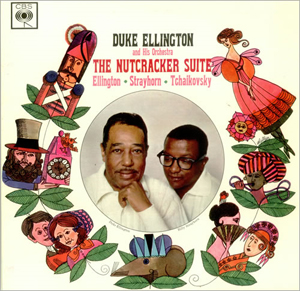
I think of many things when Christmas season rolls around, most of them pleasant. I think of parties with friends, and visits from family. I think of childhood and snowy Tennessee mountains. I think of Budweiser horses and Dr. Seuss cartoons. Then, I think of Christmas music, and I think of cutting off my ears. I don’t think I’m being deliberately contrary with regards to this music. I’ve adjusted my abrasive attitude enough times now. I’m closer to “happy” than I’ve ever been so I should be more amenable to the stuff if I were ever going to be. Apparently, I’m not. The Christmas songs I like are for the novelty. Bing Crosby and David Bowie doing “Little Drummer Boy,” for instance. No, wait! I actually like “Do They Know It’s Christmas,” but I’ll deny it if anyone ever asks. The Lennon song’s alright, and Springsteen’s “Santa Claus Is Coming To Town” is fun. Clearly, the Phil Spector Christmas album is a gem. It gets pretty scarce after that. Recently, I noticed that Pure Pleasure Records had put out Tchaikovsky’s “Nutcracker Suite” as performed by the Duke Ellington Orchestra. This is, in the parlance of the day, a “re-imagining” rather than a remake. I know these songs inside and out. Or I used to. I performed in the Nutcracker for a couple of years when I was in middle school. (You can imagine how cool I was. A 12 year old male in the Nutcracker. In Georgia. In 1986. Yep. Pretty cool. Boxing came next so I’ll let the armchair psychiatrists take it from there. Get busy and bring a lunch. You may be here for a while.) A couple of the songs on Ellington’s version, which was arranged with his musical partner, Billy Strayhorn, are all but unrecognizable. Most are instantly familiar. All are awesome. If I could divorce the songs from the season, I’d listen to this record in July. Since I can’t, I’ll be wearing it out in November and December for the foreseeable future. Maybe October. It’s that good.
I had to check out a clip of the “Overture” on iTunes to try to remember the original theme. It brought the tune back to me, but Ellington and Strayhorn really dressed this one up. It has a walking bass line that you might find in some of Tom Waits’ “beat” recordings from the early ’70’s before the horns start driving the point home. But the bass really makes it swing and it’s clearly delineated in the mix throughout this release. Things are a little bit more by the book immediately after the into. The instrumentation and melody are almost traditional on “Dance of the Reed Pipes,” but this one’s called “Toot Toot Tootie Toot.” Things more or less follow this formula for the duration of the album. The more famous passages seem less interpretive while the lesser known works are given a more liberal treatment. “Peanut Brittle Brigade,” for instance, sounds entirely unfamiliar (and rocks like crazy) to me while “Sugar Rum Cherry” is instantly discernible (although it’s much more languid and sexy than the traditional “Sugar Plum Fairy” take). The Russian dance was always my favorite to watch from the throne during performance, and I can hardly make it out after Ellington’s deconstruction, but it swings with all the might you would imagine it would once he’s had his way with it. He calls his “The Volga Vouty.” I don’t know why.
I love this record. If I were going to complain about anything it would be the extreme channel separation in the stereo mix. All of the instruments are clear and distinct, but they’re scattered across the soundstage sometimes to the point of distraction. I imagine this would be the case during a live performance too due to the amount of players involved. That seems logical to me anyway, but I may have been happier with a detailed mono mix. Regardless, the record is a ton of fun and Pure Pleasure did a heck of a job from the packaging to the pressing which is virtually flawless. A painting is more vibrant on a clean canvas, and the “canvas” for this release is almost complete silence. Granted, I have a record cleaning machine and a stylus cleaner too. I utilize both every time I play a side so my compulsion helps with the maintenance of the sound. But you can’t make a defective pressing play cleanly and this one is the opposite of defective. I can’t see anyone disliking this LP unless they were a staunch “Nutcracker” traditionalist or unless they just don’t like jazz. If you’re looking for a Christmas record for your collection just so you have something for the occasion, I would recommend this one without hesitation. And you can play it as a jazz record if you’re blind to the original version. Maybe even if you’re not…
Marvin Gaye “What’s Going On” / “Let’s Get It On” Tamla/Mobile Fidelity Sound Labs
- Performance:

- Sound:

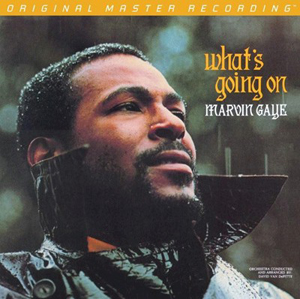
What could I possibly say about Marvin Gaye that a million blathering journalists haven’t said better already? We know that he sits proudly in the upper echelon of the all-time soul greats. The debate usually involves names like Sam Cooke, Al Green, Otis Redding,… and Gaye. Clearly, before anyone gets irate, there are plenty of others like James Brown and Little Richard, but I think of them more as “shouters” or “entertainers” rather than “vocalists.” Trying to pick a favorite is kind of like picking a favorite Stones album. There’s not one that has everything in it. There’s always something on another one that you can’t get elsewhere. And, as much as I love Green’s squirming falsetto, I have to have Otis’s gut bucket grunt as well. Marvin had a monstrous trick bag too, and we can appreciate him on so many levels as a performer and singer. But his struggle for artistic freedom during his tenure at Motown is something that could be overlooked all these years later. “What’s Going On” sounded like nothing before it that I’m aware of in music. It certainly sounded different than anything released under the Motown umbrella prior to that point, and Berry Gordy wasn’t too stoked about it on first listen. Too political, it seemed. He changed his tune when the title track took off faster than any other Motown single to that point, and he requested a full-length record to capitalise on its success ASAP. Good thinking. “What’s Going On” was immediately praised (and purchased) in significant quantities, and is rightfully considered one of the best records in any genre ever. “What’s Going On” is not a question. It’s a statement. And it was Gaye’s best seller too. Until he followed it up two years later in 1973 with “Let’s Get It On.”
If “What’s Going On” was Gaye’s entry into overt political discourse, then “Let’s Get It On” was the party after the election. Make no mistake: “Let’s Get It On” is about doing it, folks. It could almost be viewed as a reaction to the seriousness of the previous album, not unlike the hippys’ response to the social upheaval of the times. Gaye had addressed the Vietnam War and the deterioration of our urban landscape (“Whats Going On,” “Inner City Blues”) through the former effort while suggesting some spiritual solutions too (“God Is Love”). “Let’s Get It On” added the spiritual aspect to the physical act of love and helped to wash away some of the “grime of the times” once the War had ended. If music is viewed as a means of creating tension and release, then “What’s Going On” and “Let’s Get It On” might serve as the musical mural of that movement. Both records veered wildly away from what Motown was known for sonically at the time. Both albums employ themes and reprises, lyrical and musical. These are soul/funk concept albums of a most serious nature. Gaye had seized his artistic freedom as artist and producer in a power play that must have taken years off Gordy’s life. Until Gordy was able to buy those years back with the checks he received from Gaye’s success, that is. This fact can’t be overstated. It gave the stable of Motown artists room to explore as Stevie Wonder and the Temptations moved into the socio-political realm, and it also served as an update for the “Motown Sound” which was being squeezed out by the emerging funk sound amongst others. I’m not sure we’d have had “Papa Was a Rollin’ Stone” or “Songs In the Key of Life” without Marvin’s prior works to kick the door down, and a world without those records is a world I’d rather not consider. Why don’t we just board up all the museums while we’re at it? Turn the Grand Canyon into a used car lot… See what I mean?
And here’s the kick: you can still get new copies of both of Gaye’s records by Mobile Fidelity. No “0’s” or “1’s” involved with these sounds, this is all from the tape. They come with everything you’d expect from MoFi too. Sturdy outer covers with high-quality liners for protection. Complete silence between sounds and musical clarity on par with an intimate jazz performance in a room designed specifically for such things. You can almost make out the famous dialogue sections in “What’s Going On.” Gaye seems to jump up from behind your couch to shout the intro to “Let’s Get It On” directly into your ear. The sound stage is completely balanced with Gaye’s vocals prominently featured while the spaces between notes are distinct and as clear as can be. I consistently find MoFi releases to be of superior quality when compared even to the originals. I just get the feeling that MoFi is doing exactly what the original producers would have done were the same technology available at the time. If you’re a Marvin Gaye fan and you’re into analogue production, these two are essential.
Smokey Robinson and the Miracles “Going to a Go-Go” Tamla/Speakers Corner
- Performance:

- Sound:

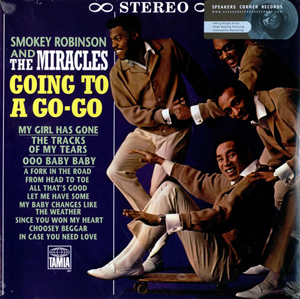
So, who was responsible for building the sound that Marvin Gaye dismantled in 1971? If I had to pick one person as a performer, producer, writer and arranger, I’d go with William “Smokey” Robinson. (Would I even have another option given the criteria?) If the Motown Sound were prize fighting, Robinson would be Muhammad Ali. Forget the fact that he served as Motown’s vice-president for almost 30 years. Forget the fact that Robinson’s group, the Miracles, had Motown’s first million-selling single. Robinson wrote hits for the Temptations, Mary Wells, the Four Tops, and damn near everyone else in Detroit. Add that to the literally dozens of hits the Miracles had on their own and you start to realize how wide was the swath that Smokey cut through the fabric of popular American culture. His staunchest supporters were no less than John Lennon and Bob Dylan, speaking of heavyweights. Before I was old enough to seek out live acts in smokey bars, I thought music only existed on the radio. And that was rough because I came of age in the ’80’s. Luckily, my mom turned me on to Motown right when I was in danger of getting sucked up by hair metal. I think it was the Motown TV specials that did it. First, Motown’s 25th Anniversary when Michael Jackson moonwalked off the stage and into history (after I’d gone to bed). Then, Motown Returns to the Apollo which I remember as a big-time game changer. After that, my mom never had to worry about taking me to see Ratt at the Civic Center (with Bon Jovi opening). But she was standing there next to me while I donned a tuxedo shirt and grooved to the Tempts & Tops. I couldn’t believe my thirteen year old eyes. It was like these folks grew up out of the stage in sequins and slacks, like they’d never been anywhere else. Somehow, the Miracles didn’t make as much of an impression when I was a kid. In my youth, I overlooked the writer that gave so much substance to the flashier Temptations repertoire. Well, I’ve fixed that now. I picked up Smokey Robinson and the Miracles’ “Going To A Go-Go” as issued by Speakers Corner. I was blind, but now I see.
In the old days, I kept my rock rocking and my soul smooth, and never the twain had met. At least, I didn’t realize they’d met. I forgive myself. I was new to this. Now, I find “Going To A Go-Go” rocking as hard as “Let It Bleed” in its own glorious way. The title track’s swampy backbeat is just so wonderfully gnarly, I don’t know how I could have missed it on the first go ’round. The female vocal, courtesy of the uncredited Claudette Rogers, lets you know that the boys won’t be partying alone which is the whole key to partying anyway. We all know “Tracks Of My Tears,” and the insanely sweet “Ooo Baby Baby,” but the nuances and details had escaped me until now. I’d always thought of Motown as a hit factory based on popular singles more so than long-players. And that’s not inaccurate. But there were LPs that stood as complete works even in the ’60’s, before Marvin and Stevie re-wrote the rules. The Temptations’ “Cloud Nine,” for instance, was an interesting mixture of the old and new sounds split evenly between two sides. The sound was not cohesive, but the music was beyond solid. Admittedly, there are certainly others that I haven’t found yet so “Go-Go” serves as my intro to a new world of Motown’s deep cuts. That’s exciting news after all these years, and it makes sense that it should come from the label’s bedrock band. The record contains four top twenty hits and eight more that could have been if not for the strength of the songs that were. The sound is dirtier than I remember too. Even on “Ooo Baby Baby,” the grit is in the grooves.
The folks at Speakers Corner aren’t playing around either. They claim to have no digital content in their catalogue. None. They say the only exception would be if the master recording were partially or entirely digital, but they have no such recordings available at present. They claim to use the original masters unless a master has been damaged or lost, in which case they use the first generation copy. This is reportedly rare. All this sounds accurate to me. At $35 a pop it should be. And the record should be without pops, cracks or ticks and the ones that I have are. Motown recordings are not your standard audiophile fair. They’re decidedly (and deliciously) rough. Often there’s precious little separation between the instruments. But the voices cut through whether by means of talent or production or a combination of both. You certainly won’t have a hard time hearing Smokey sing on this one. And the Miracles were so much more accomplished with their harmonies than I’d ever noticed before. They say that getting old is hell. But I’ve had a blast making these connections to early rock and roll, country, soul music, and even hip-hop. The sounds are diverse, but the attitude is pervasive. I call it rock and roll, but I could have just as easily landed on another label with identical results: big fun. This is the quintessential “Motown Sound” from which Marvin Gaye would later diverge. (Note: the Speakers Corner label on the pictured disc is a sticker on the outer wrapper. It is not printed on the actual cover. SC seems to take some amount of time with the reproductions of the original artwork on their releases. Hats off.)


